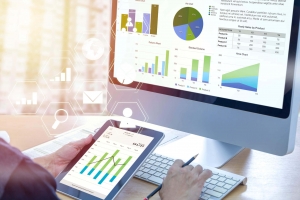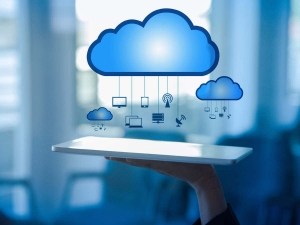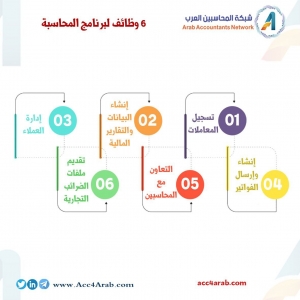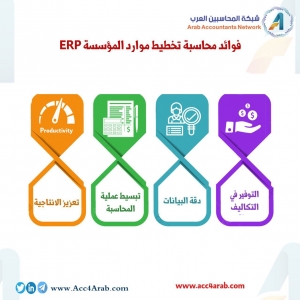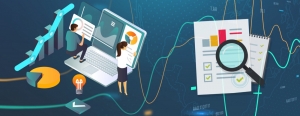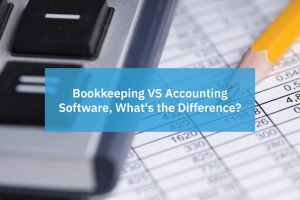عرض العناصر حسب علامة : برامج المحاسبة
7 خطوات لتغيير برامج المحاسبة
بصفتك صاحب شركة، لديك بالفعل ما يكفي على برنامج المحاسبة الذي تستخدمه. لا يوجد سبب للاحتفاظ ببرنامج محاسبة لا يلبي احتياجاتك حيث يمكن أن يؤدي تغيير برامج المحاسبة إلى جعل عملك اليومي أكثر سلاسة من أي وقت مضى.
رسالة ماجستير: مدى ملاءمة مهنة المحاسبة لبيئة التجارة الإلكترونية وفقاً لمتطلبات المعيار المحاسبي الدولي 18 الإعتراف بالإيراد
هدفت هذه الدراسة إلى التحقق من توافق عمليات الإعتراف بالإيراد في بيئة التجارة الإلكترونية مع متطلبات المعيار الدولي رقم 18، حيث سعت إلى تحقيق مجموعة من الأهداف تمثلت في تحليل آليات وأساليب الإعتراف بالإيراد الناتج عن بيع السلع والخدمات في التجارة الإلكترونية ومدى الإنسجام مع المعيار الدولي، والتعرف على المبادىء المحاسبية المستخدمة لقياس الإيراد في بيئة التجارة الإلكترونية ومدى إنسجامها مع المعيار الدولي
اتجاهات التكنولوجيا القائمة على السحابة في شركات المحاسبة
المتطلبات التنظيمية المتطورة هي مجرد جزء من المعادلة عندما يتعلق الأمر باتجاهات الصناعة الناشئة التي تؤثر على مهنة المحاسبة.
معلومات إضافية
-
المحتوى بالإنجليزية
The Three Emerging Cloud-based Technology Trends Transforming Accounting Firms
Evolving regulatory requirements are just part of the equation when it comes the emerging industry trends impacting the accounting profession. Technology and the ongoing innovations in cloud-based solutions are likely to be one of the most transformative forces in your practice over the next three-to-five years.
Research firm Gartner estimates that by 2024 more than 45% of IT spending will shift to cloud-based technologies, and in many instances, this will include accounting software—driving the demand for accountants with strong cloud accounting software skills.
Key to the changing technology landscape for accounting firms is the introduction of new tools with real-time data analytics and artificial intelligence (AI). To thrive in this new technological ecosystem, accounting firms will need to have a clean, reliable, and secure data infrastructure. This may present a challenge for firms that have legacy on-premises systems, not only from a cybersecurity and workflow standpoint, but also in terms of revenue.
This is because it is only by using a new breed of cloud-based accounting systems that firms can open the door to automated financial reporting, cash management, accounts payable, and month-end close processes. The automation of these tasks will increase your firm’s productivity and profitability.
With this in mind, here is a closer look at the three technologies poised to have a lasting impact on the accounting profession: AI, analytics and cybersecurity.
1. Artificial intelligence. Once considered a futuristic technology, AI is now considered by many to be mainstream. There is a growing consensus that AI can and will have a significant impact on just about every industry and business role.
Accounting firms and their clients are already implementing solutions featuring AI to automate mundane, easily repeatable tasks, freeing employees and firm owners to focus their time on higher-value activities.
How will AI impact your firm? Consider this example: using machine learning, a type of AI, a company can feed a year’s worth of expense reports into a travel and expense system with the goal of teaching it to flag anomalies that might indicate fraud or human error. The more reports the system has to study, and the more time it spends analyzing them, the better it becomes at identifying potential issues, creating the opportunity for time and cost savings.
2. Analytics. One of the key advantages of cloud-based technologies incorporating AI and machine learning is the advanced analytics capabilities they offer for users. When more data can be analyzed more quickly with advanced reporting tools, the output is richer and offers deeper insights. This allows accountants to not only save time and increase productivity on data processing functions, but also provides the opportunity to offer additional advisory services and add more value to client relationships.
3. Cybersecurity. Using cloud-based technologies is often more secure than on-premises versions because the right vendor will store all of the client and other data your team has stored in accordance with leading cybersecurity practices most businesses cannot match on their own. In addition, the technology provider will update your solutions frequently in response to emerging security threats. This provides peace of mind to your clients and mitigates liabilities for your firm. Cloud systems also provide the redundancy necessary for business continuity should you need to relocate your firm, work remotely, or face some other business disruption.
It is now a fact: cloud-based technology innovations are disrupting the accounting industry. This trend is quickly transforming what used to seem like futuristic applications and use cases into mainstream solutions. Over the next few years, the technologies described above, along with other developments, will help accountants increase the efficiency of their workflows, access richer data, securely serve their clients, and extract additional insights from every accounting process. The only remaining question is, how will your firm respond?
كيفية اختيار برنامج المحاسبة المناسب لعملك
ربما تفكر في شراء برنامج محاسبة لأول مرة او تفكر في تبديل البرنامج الذي تستخدمه حالياَ في مرحلة ما، قد تتساءل عن كيفية اختيار برنامج المحاسبة المناسب هناك العديد من الخيارات المتاحة امامك ولكن قد تشعر انك لا تعلم اي منها المناسب لك.
معلومات إضافية
-
المحتوى بالإنجليزية
Maybe you’re thinking about buying accounting software for the first time. Or, you’re finally ready to switch software providers. At some point, you may wonder how to choose accounting software. There are so many options out there that even knowing where to get started selecting the right accounting software can feel impossible. This article will help you learn how to choose accounting software that fits your needs.
How to choose the right accounting software for your business
How to choose the right accounting software for your small business can make your head spin. Your company has specific needs. And with so many software features, price points, commitment timelines (one-time charge or subscription), and everything else, it can be tough to keep things straight.
To sort through your options, consider the following five tips.
1. Choose accounting software that fits your budget
Before you get started, you should know the cost of accounting software varies. The amount often increases with the number of features the software provides. Want more features? You may have to shell out some more money.
It’s important to understand how the price compares to available features when choosing accounting software. The last thing you want is overpriced software with a bunch of features you’ll never use. Check and see if the software offers a free trial or self-guided demo before purchasing. If they do, you’ll get to know the software’s features before you commit.
Watch out for how you are charged for the software. Software companies often have different methods for charging users. Some software applications are sold at a large, one-time fee. Depending on the software, you might have to pay additional expenses for updates when they come up. If this is the case, you won’t be able to plan ahead of time for the new fee. If the update is needed, you’ll need to pay for it.
Other software programs work on a monthly or yearly subscription. They are often sold in packages with a tiered pricing structure that allows you to choose exactly what you need. If you choose software that charges a monthly fee, know the terms before subscribing.
Make sure that you understand your contract—is it flexible or iron-clad? If you break a contract, you could be charged a fee.
Last but not least: watch out for the hidden or additional fees. You don’t want to be surprised by extra charges for creating invoices, running reports, providing setup, customer service, and data storage.
2. The best accounting software is the one you know how to use
If you’re like many small business owners, you have a depth of knowledge in your specific field, not accounting. You don’t want to spend your workweek learning bookkeeping.
Sure, you might not technically be a bookkeeper, but you aren’t new to money management. You’ve been managing your finances ever since you first debated whether or not you should break your piggy bank or fill it up some more.
With that being said, accounting software comes with all different types of skill levels in mind. Some are simple and made for the nonaccountant. Others are more suited for accountants. In the end, it doesn’t matter who you are. You should look for software that offers free resources and customer support. That way, if you do need to learn something new, there’s an easy way to make sure you have the right information.
3. Decide the features you need for accounting software
The good thing about having so many features to choose from is that you get to find the accounting software that fits your needs like a glove.
Here are some common features you might come across:
Create and track invoices
Pay vendors
Compile financial statements
Process credit cards
Integrate with bank accounts
Record customer histories
We all love a good checklist. To help organize your search, make a checklist of all the features you need. Prioritize the list from the most necessary features to the least.
Find a software solution that supports both current needs and future needs. Find software that can grow with your business.
4. On-the-go owners must look for flexibility
If you find yourself loosely defining the word “office” to include cafes, airport lounges, and your favorite restaurant, you may want to look into cloud-based accounting software.
Cloud-based software stores information online so you can access the program anywhere with any device connected to the internet. There are a lot of upsides here: You aren’t tethered to a desk, and you don’t have to worry about losing accounting information if your computer crashes on you.
If you do choose desktop software, you should know the risks. That single computer and its hard drive become the center point of your workweek. And, the software is only available to you if your computer is in tip-top shape. Crashes, water damage, and power outages can wreak havoc on your accounting records.
5. Make sure that quality customer support is there when you need it
You may have questions or need help understanding your new software. And when that time comes, you’ll want a support team that can help quickly and easily. Quality customer support that is knowledgable and easy to get a hold of will be key to switching over to new software.
Here are some questions to keep in mind when thinking about customer support:
Is the support free, or are there additional, even recurring fees?
What time zone are they in? Make sure you don’t lose too much time between different time zones.
Is the support team experienced and knowledgeable about the software and your needs?
Is there more than one way to get ahold of customer support (e.g., phone, email, online chat)?
How to choose accounting software
The items listed above are just a starting point. You also need to consider the following:
Reports: Look for easy-to-read reports that are shareable with your accountant, managers, or other trusted employees.
Accounting method: Choose accounting software that matches your preferred accounting method.
Security: Make sure that the software has your security interests in mind.
Commitment: Choose month-to-month or annual commitments (whichever fits your needs).
Reviews: Trust customers who’ve been using the software for weeks, months, and even years—let them tell you just how good the software is.
إمساك الدفاتر
معلومات إضافية
-
المحتوى بالإنجليزية
Introduction to Bookkeeping
Did you know? To make the topic of Bookkeeping even easier to understand, we created a collection of premium materials called AccountingCoach PRO. Our PRO users get lifetime access to our bookkeeping video training, cheat sheet, flashcards, quick test, tests for prospective employees, guide to bookkeeping concepts, and more.
The term bookkeeping means different things to different people:
Some people think that bookkeeping is the same as accounting. They assume that keeping a company's books and preparing its financial statements and tax reports are all part of bookkeeping. Accountants do not share their view.
Others see bookkeeping as limited to recording transactions in journals or daybooks and then posting the amounts into accounts in ledgers. After the amounts are posted, the bookkeeping has ended and an accountant with a college degree takes over. The accountant will make adjusting entries and then prepare the financial statements and other reports.
The past distinctions between bookkeeping and accounting have become blurred with the use of computers and accounting software. For example, a person with little bookkeeping training can use the accounting software to record vendor invoices, prepare sales invoices, etc. and the software will update the accounts in the general ledger automatically. Once the format of the financial statements has been established, the software will be able to generate the financial statements with the click of a button.
At mid-size and larger corporations the term bookkeeping might be absent. Often corporations have accounting departments staffed with accounting clerks who process accounts payable, accounts receivable, payroll, etc. The accounting clerks will be supervised by one or more accountants.
Our explanation of bookkeeping attempts to provide you with an understanding of bookkeeping and its relationship with accounting. Our goal is to increase your knowledge and confidence in bookkeeping, accounting and business. In turn, we hope that you will become more valuable in your current and future roles.
Confused? Send Feedback
Bookkeeping: Past and Present
Bookkeeping in the Old Days
Prior to computers and software, the bookkeeping for small businesses usually began by writing entries into journals. Journals were defined as the books of original entry. In order to reduce the amount of writing in a general journal, special journals or daybooks were introduced. The special or specialized journals consisted of a sales journal, purchases journal, cash receipts journal, and cash payments journal.
The company's transactions were written in the journals in date order. Later, the amounts in the journals would be posted to the designated accounts located in the general ledger. Examples of accounts include Sales, Rent Expense, Wages Expense, Cash, Loans Payable, etc. Each account's balance had to be calculated and the account balances were used in the company's financial statements. In addition to the general ledger, a company may have had subsidiary ledgers for accounts such as Accounts Receivable.
Handwriting the many transactions into journals, rewriting the amounts in the accounts, and manually calculating the account balances would likely result in some incorrect amounts. To determine whether errors had occurred, the bookkeeper prepared a trial balance. A trial balance is an internal report that lists 1) each account name, and 2) each account's balance in the appropriate debit column or credit column. If the total of the debit column did not equal the total of the credit column, there was at least one error occurring somewhere between the journal entry and the trial balance. Finding the one or more errors often meant spending hours retracing the entries and postings.
After locating and correcting the errors the bookkeeping phase was completed and the accounting phase began. It began with an accountant preparing adjusting entries so that the accounts reflected the accrual basis of accounting. Adjusting entries were necessary for the following reasons:
additional revenues and assets may have been earned but were not recorded
additional expenses and liabilities may have been incurred but were not recorded
some of the amounts that had been recorded by the bookkeeper may have been prepayments which are no longer prepaid
depreciation and other non-routine adjustments needed to be computed and recorded
After all of the adjustments were made, the accountant presented the adjusted account balances in the form of financial statements.
After each year's financial statements were completed, closing entries were needed. The purpose of closing entries is to get the balances in all of the income statement accounts (revenues, expenses) to be zero before the start of the new accounting year. The net amount of the income statement account balances would ultimately be transferred to the proprietor's capital account or to the stockholders' retained earnings account.
Bookkeeping Today
The electronic speed of computers and accounting software gives the appearance that many of the bookkeeping and accounting tasks have been eliminated or are occurring simultaneously. For example, the preparation of a sales invoice will automatically update the relevant general ledger accounts (Sales, Accounts Receivable, Inventory, Cost of Goods Sold), update the customer's detailed information, and store the information for the financial statements as well as other reports.
The accounting software has been written so that every transaction must have the debit amounts equal to the credit amounts. The electronic accuracy also eliminates the errors that had occurred when amounts were manually written, rewritten and calculated. As a result, the debits will always equal the credits and the trial balance will always be in balance. No longer will hours be spent looking for errors that occurred in a manual system.
CAUTION: While the accounting software is amazingly fast and accurate in processing the information that is entered, the software is unable to detect whether some transactions have been omitted, have been entered twice, or if incorrect accounts were used. Fraudulent transactions and amounts could also be entered if a company fails to have internal controls.
After the sales invoices, vendor invoices, payroll and other transactions have been processed for each accounting period, some adjusting entries are still required. The adjusting entries will involve:
revenues and assets that were earned, but not yet entered into the software
expenses and liabilities that were incurred, but not yet entered into the software
prepayments that are no longer prepaid
recording depreciation expense, bad debts expense, etc.
The adjusting entries will require a person to determine the amounts and the accounts. Without adjusting entries the accounting software will be producing incomplete, inaccurate, and perhaps misleading financial statements.
After the financial statements for the year are released, the software will transfer the balances from the income statement accounts to the sole proprietor's capital account or to the stockholders' retained earnings account. This allows for the following year's income statement accounts to begin with zero balances. (The balance sheet accounts are not closed as their balances are carried forward to the next accounting year.)
Recording Transactions
Bookkeeping (and accounting) involves the recording of a company's financial transactions. The transactions will have to be identified, approved, sorted and stored in a manner so they can be retrieved and presented in the company's financial statements and other reports.
Here are a few examples of some of a company's financial transactions:
The purchase of supplies with cash.
The purchase of merchandise on credit.
The sale of merchandise on credit.
Rent for the business office.
Salaries and wages earned by employees.
Buying equipment for the office.
Borrowing money from a bank.
لماذا تحتاج جميع الشركات إلى برامج التقارير المالية؟
كل عمل يحتاج إلى برنامج لإعداد التقارير المالية إذن كيف تختار البرنامج المناسب؟ حسنًا، لفهم أداء الأعمال وكيفية إنشاء استراتيجيات فعالة، تحتاج إلى أداة تساعدك في رسم التحليل المالي من كل زاوية. دعونا نلقي نظرة على أفضل ميزات إعداد التقارير المالية للبحث عنها في برامج المحاسبة.
ما الفرق بين برمجيات مسك الدفاتر وبرمجيات المحاسبة
دعنا نتعمق في الاختلافات بين مسك الدفاتر وبرمجيات المحاسبة لفحص ما تحتاجه حقًا لأفضل إدارة مالية. في كثير من الأحيان، يتم استخدام مصطلحات مسك الدفاتر والمحاسبة بالتبادل. لكن هذه مفاهيم مختلفة، تنعكس بوضوح في التكنولوجيا الحديثة.
معلومات إضافية
-
المحتوى بالإنجليزية
Bookkeeping vs Accounting
When you compare bookkeeping vs accounting, they both involve managing financial transactions and accounts. The difference lies in the scale and depth of these processes.
Bookkeeping is simply the recording and monitoring of financial transactions. These include sales transactions, purchases, receipts, and payments made by the company.
Accounting is more complex. Accounting refers to the documentation, interpretation, analysis, classification, and summarization of financial data.
So, while the two are related, they address two different aspects of financial management. Primarily, bookkeeping logs financial information and may involve rolling up the details, while accounting tracks the financial data, manages it, and then uses the data to enhance business. However, this divide has shifted substantially thanks to how they’re used in IT software. To learn more about accounting definitions and terms, check out our accounting vocabulary page.
Bookkeeping Software vs Accounting Software, What’s the Difference?
Bookkeeping software concentrates on the basic components of financial management. You’ll use a bookkeeping system like QuickBooks to document your finances and pay bills. But that’s mostly it. Bookkeeping software focuses on data entry and storage. This is what you use to log your revenue and pay expenses.
Accounting software performs all the functions of bookkeeping in addition to more analytical and actionable accounting functions like cash flow analysis and forecasting. Besides logging and processing debits and credits, accounting systems consolidate key data needed for more proactive financial strategies. What gives accounting software an edge is its proactive use of data.
What’s the Role of Data in a Business’ Financial Health?
One defining feature of both modern accounting and IT technology is data. The use of data even dictates the roles of both bookkeepers and accountants.
Bookkeepers don’t necessarily need an accounting degree or a financial background like an accountant or CPA. They just know proper financial data entry in order to record the transactions properly. This is more of a clerical role, which is still important because accuracy is critical for accounting and finances. However, bookkeeping ends at recording and updating information. This is where the accountant takes over.
Accountants can do bookkeeping work as well, but they are primarily an advisor. Today, the accountant is the curator of your financial data. Accountants take the financial transactions, account information, and other related financial data, and analyze how these details indicate business performance. They then use this financial data to help businesses make the best decisions for success. Accounting software helps accountants do this by capturing and presenting data in a way that helps identify trends and make accurate projections.
[So] Which is the Best Accounting Technology?
It’s pretty obvious that accounting software is better than bookkeeping software. Accounting software is designed to let you do more and visualize your financial health more clearly. You simply get more for what you pay for. Therefore, you should be looking to use or upgrade to a dedicated accounting app, right? Not necessarily.
Accounting applications, while more useful than bookkeeping software, still have several limitations. They can be rigid in how you use, assess, and process financial data or manage transactions. You’ll get the best value and use out of an accounting platform like Accounting Seed than you would a typical accounting app.
Bookkeeping and Accounting: Accounting Platforms
Essentially, an accounting platform combines the goals and functions of bookkeeping and accounting software, but that’s not all. This is because IT platforms are designed for individual organizations to build on top of them. Accounting and bookkeeping applications can be restrictive. They’re not very flexible in how users can work with their own requirements. This isn’t the case with accounting platforms.
Accounting platforms bring a full complement of financial features, the functionality to be adjusted, and an increased emphasis on data control. In summary, the choice is simple. Companies don’t need to choose between bookkeeping or accounting because accounting platforms bring a full-scale accounting solution that will continue to adapt to their needs.
برنامج محاسبة دفتر الأستاذ العام لعملك
يعد دفتر الأستاذ العام أحد ركائز نظام الإدارة المالية لمؤسستك. لقد جعلت برامج المحاسبة المستندة إلى السحابة بالتأكيد محاسبة دفتر الأستاذ العام أسهل بكثير، ولكن فقط مع ميزات البرنامج الصحيحة. دعنا نلقي نظرة سريعة على الأساسيات الكامنة وراء محاسبة دفتر الأستاذ العام ونفحص ميزات البرنامج التي تجعل إدارة هذه العملية أمرًا في غاية السهولة.
معلومات إضافية
-
المحتوى بالإنجليزية
What is a General Ledger?
To review, the general ledger is the database that contains all of the business transactions of the organization. The transactions are listed in the chart of accounts where they’re grouped based on their type: assets, equity, liabilities, expenses, and revenue. These transactions are closed out and a trial balance is created to report each account’s balance. This is what’s used to develop financial statements.
The general ledger is crucial for ongoing business performance analysis because it provides a comprehensive record of all business financial activities. It’s important to maintain this data accuracy as much as possible through efficient accounting.
General Ledger Accounting: The Basics
General ledger accounting relies on the double-entry method to record transactions. This means that all transactions are posted at least two times in order to account for and balance the effect of each transaction.
For example, when a company gains a loan of $5K the cash of the company increases, therefore an asset entry of $5K is created. But simultaneously, a liability transaction is also created. This is because the loan must be paid off. To account for the repayment of the loan, the cash entry also creates a debit and credit entry.
This lets you visualize the precise effects of all your company’s activities. At the same time, this helps maintain the accuracy of what you’re reporting since transactions are listed twice. You then balance your finances by cross-examining the various entries generated by the single transaction.
General Ledger Accounting Software for Your Business
When it comes to managing your general ledger accounting effectively, your choice of software plays a major role. Here’s what features to look for:
You’ll want to invest in software that’s flexible, letting you easily adapt your general ledger to new requirements without coding. Being able to configure your system for adjustments rather than having to use code is much faster and easier.
Your accounting software should also have a flexible tagging system for your general ledger. This lets you organize your ledger in a way that makes sense for your company’s operations and financial needs.
Validating data entries in the general ledger is much easier and more accurate with a collaborative accounting system. Through increased visibility over company data, you and your team can pinpoint errors and validate correct amounts as an efficient unit.
Robust reporting features are also important for general ledger accounting. Isolating and reporting on specific entries and accounts helps you truly understand what is driving financial data. This also eliminates guesswork and provides definitive information needed to make the best business decisions possible.
Ensure general ledger accuracy with an accounting system that is connected to the source transactions – applications that initiate transactions. Manually logging each entry into the accounting system is time-consuming. It also opens your ledger up to potential human errors. Generating a transaction that automatically creates the entries in your general ledger saves time and maintains data accuracy between operations and accounting systems. For example, with Salesforce, you can create an order with one application on the platform and generate a ledger entry automatically with a native accounting software like Accounting Seed.

